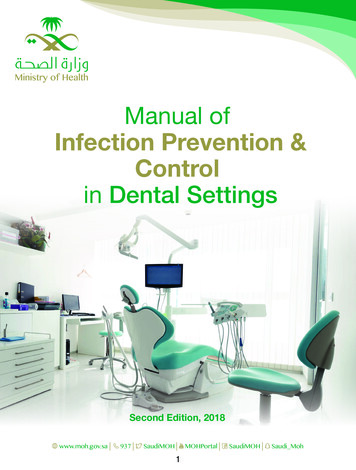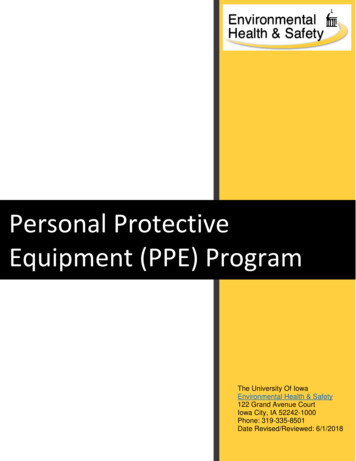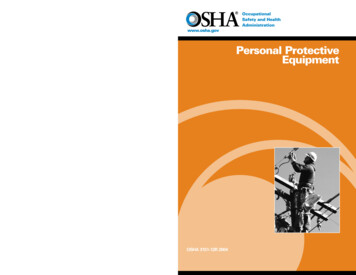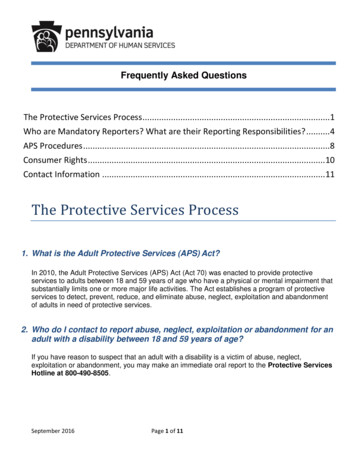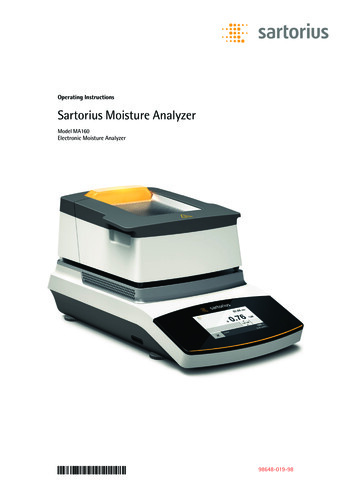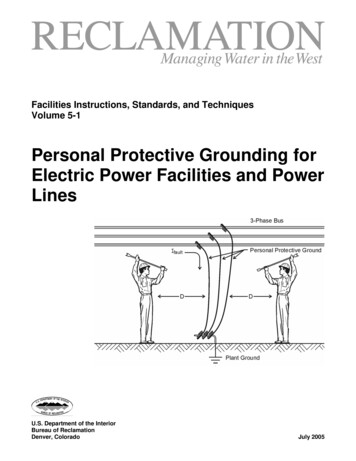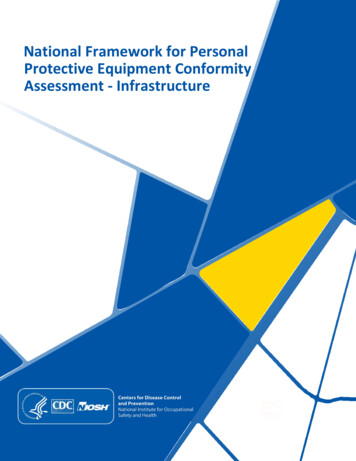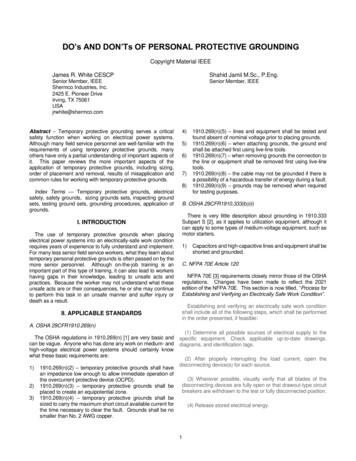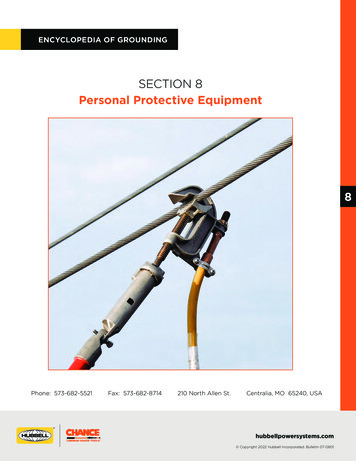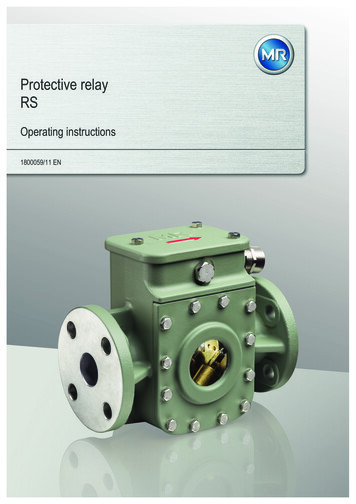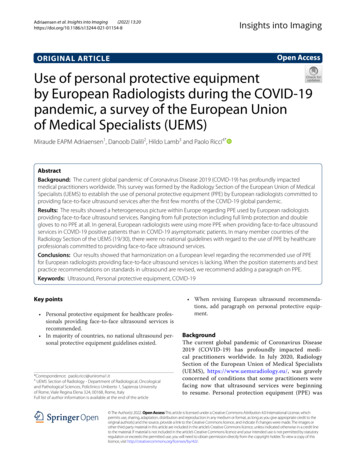
Transcription
(2022) 13:20Adriaensen et al. Insights into nsights into ImagingOpen AccessORIGINAL ARTICLEUse of personal protective equipmentby European Radiologists during the COVID‑19pandemic, a survey of the European Unionof Medical Specialists (UEMS)Miraude EAPM Adriaensen1, Danoob Dalili2, Hildo Lamb3 and Paolo Ricci4*AbstractBackground: The current global pandemic of Coronavirus Disease 2019 (COVID-19) has profoundly impactedmedical practitioners worldwide. This survey was formed by the Radiology Section of the European Union of MedicalSpecialists (UEMS) to establish the use of personal protective equipment (PPE) by European radiologists committed toproviding face-to-face ultrasound services after the first few months of the COVID-19 global pandemic.Results: The results showed a heterogeneous picture within Europe regarding PPE used by European radiologistsproviding face-to-face ultrasound services. Ranging from full protection including full limb protection and doublegloves to no PPE at all. In general, European radiologists were using more PPE when providing face-to-face ultrasoundservices in COVID-19 positive patients than in COVID-19 asymptomatic patients. In many member countries of theRadiology Section of the UEMS (19/30), there were no national guidelines with regard to the use of PPE by healthcareprofessionals committed to providing face-to-face ultrasound services.Conclusions: Our results showed that harmonization on a European level regarding the recommended use of PPEfor European radiologists providing face-to-face ultrasound services is lacking. When the position statements and bestpractice recommendations on standards in ultrasound are revised, we recommend adding a paragraph on PPE.Keywords: Ultrasound, Personal protective equipment, COVID-19Key points Personal protective equipment for healthcare professionals providing face-to-face ultrasound services isrecommended. In majority of countries, no national ultrasound personal protective equipment guidelines existed.*Correspondence: paolo.ricci@uniroma1.it4UEMS Section of Radiology ‑ Department of Radiological, Oncologicaland Pathological Sciences, Policlinico Umberto 1, Sapienza Universityof Rome, Viale Regina Elena 324, 00168, Rome, ItalyFull list of author information is available at the end of the article When revising European ultrasound recommendations, add paragraph on personal protective equipment.BackgroundThe current global pandemic of Coronavirus Disease2019 (COVID-19) has profoundly impacted medical practitioners worldwide. In July 2020, RadiologySection of the European Union of Medical Specialists(UEMS), https:// w ww. uemsr adiol ogy. eu/, was gravelyconcerned of conditions that some practitioners werefacing now that ultrasound services were beginningto resume. Personal protection equipment (PPE) was The Author(s) 2022. Open Access This article is licensed under a Creative Commons Attribution 4.0 International License, whichpermits use, sharing, adaptation, distribution and reproduction in any medium or format, as long as you give appropriate credit to theoriginal author(s) and the source, provide a link to the Creative Commons licence, and indicate if changes were made. The images orother third party material in this article are included in the article’s Creative Commons licence, unless indicated otherwise in a credit lineto the material. If material is not included in the article’s Creative Commons licence and your intended use is not permitted by statutoryregulation or exceeds the permitted use, you will need to obtain permission directly from the copyright holder. To view a copy of thislicence, visit http:// creat iveco mmons. org/ licen ses/ by/4. 0/.
Adriaensen et al. Insights into Imaging(2022) 13:20a particular concern with many countries not able tosafely conduct ultrasound examinations, putting frontline practitioners at unnecessary risk [1]. Whilst wedid not yet fully understand this disease in July 2020,we did know that Black, Asian and minority ethnicgroups amongst medical practitioners and ancillaryhealthcare staff were amongst the highest mortalityrates [2, 3].This survey was formed by the Radiology Sectionof the UEMS to establish the use of PPE by European radiologists committed to providing face-to-faceultrasound services after the first few months of theCOVID-19 global pandemic.MethodsStudy designA questionnaire was developed collaboratively by representatives of the Radiology Section of the UEMSwho approved international distribution of this survey in July 2020. In-line with previous studies, the freeonline web-based software “Google Forms” (GoogleLLC, Mountain View, CA, USA) was utilised to createand disseminate the survey and collect responses. Inaccordance with National Health Service (NHS) HealthResearch Authority criteria, this study did not requireapplication for ethical approval [4]The anonymised survey was composed of 31 questions; with the full list of questions and answers displayed in Table 1. Five questions required answers asmultiple-choice (Likert or dichotomous) selections andthe remaining twenty-six questions were ‘yes’ or ‘no’questions. There were free text boxes available whereelaboration to answers was invited. On July 22, 2020,invitations to participate in the survey were distributedvia email to all representatives of the Radiology Sectionof the UEMS and its Divisions of Interventional Radiology and Neuroradiology. During the summer of 2020two reminders were sent. Following a unanimous decision by the authors, the survey was concluded after twomonths in September 2020.Data analysisData were collected and tabulated independently viaGoogle Forms (Google Forms, Google LLC, CA). Additionally, all responses were collected in an electronicspreadsheet (Microsoft Excel, Microsoft, Redmond,VA). The results were analysed by two researcherswho have been previously involved in survey studiesamong other things performed by the ACI (Accreditation Council in Imaging), the ESSR (European Societyof Musculoskeletal Radiology), and the BSSR (BritishPage 2 of 8Society of Skeletal Radiology). Descriptive statisticswere used to summarise multiple-choice responses,with results expressed as number of respondents andpercentages. A narrative analysis was conducted on thefree text question to identify recurring themes.ResultsThe survey was distributed among all 31 member countries of the Radiology Section of the UEMS and itsDivisions. Answers were received from 46 participantsrepresenting UEMS delegates from 30 European countries out of 31 member countries (97%) (Fig. 1). The fulllist of answers from all 46 respondents are presentedin Table 1. The absolute number of completed answers,stratified by country is reported in Table 2.In total, 74% (34/46) of answers were received frommembers who practiced in university hospitals, 13%(6/46) had worked in teaching hospitals and 17% (8/46)had performed ultrasounds in general hospitals. A further 7% (3/46) had been exposed to ultrasound in privatepractice and 2% (1/46) in an elective outpatient clinic.The majority (83%; 38/46) of participants practicedgeneral ultrasound, with just under a half (43%; 20/46)performed musculoskeletal ultrasound (Fig. 2). A number of participants also expressed performing otherultrasound examinations such as vascular (11%; 4/46),interventional (11%; 4/46) and paediatric (4%; 2/46)(Fig. 2).With regard to dedicated PPE being worn by COVID19 positive patients, 54% (25/46) respondents reportedthat patients wore surgical masks to appointments,whilst a further 22% (10/46) and 20% (9/46) of participants reported patients as wearing Filtering Facepiece(FFP)2 and FFP3 masks, respectively. 4% (2/46) respondents stated that COVID-19 positive patients did not wearfacemasks in their department. With respect to goggles,72% (33/46) of respondents stated that COVID-19 positive patients did not wear goggles in the department anda majority of 63% (29/36) reported face shields not beingworn. 52% (24/46) of responses stated that patients woregowns and the same number was also seen for gloves(52%; 24/46). Very few (15%; 7/46) respondents reportedthe use of a plastic screen/wall when scanning COVID19 positive patients.Where patients have been found to be COVID-19positive, respondents reported that all radiologists woremasks with 26% (12/46) wearing surgical masks, 39%(18/46) wearing FFP2 masks and 35% (16/46) wearingFFP3 masks. Furthermore, the majority of respondentsreported that radiologists used goggles (80%; 37/46),face shields (83%; 38/46), gowns (96%; 44/46) and gloves(98%; 45/46). The use of plastic screens still remained lowwith only 20% (9/46) of respondents reporting their use.
Adriaensen et al. Insights into Imaging(2022) 13:20Page 3 of 8Table 1 Full list of questions included in the survey and answers from 46 respondentsQuestionAnswerBackground information1. Which country are you working in?Austria: 2 (4.3%)Bulgaria: 2 (4.3%)Croatia: 1 (2.2%)Cyprus: 1 (2.2%)Czech Republic: 1 (2.2%)Denmark: 1 (2.2%)Estonia: 2 (4.3%)Finland: 1 (2.2%)France: 2 (4.3%)Greece: 1 (2.2%)Germany: 1 (2.2%)Hungary: 3 (6.5%)Iceland: 2 (4.3%)Ireland: 1 (2.2%)Italy: 2 (4.3%)Latvia: 1 (2.2%)Lithuania: 1 (2.2%)Luxembourg: 1 (2.2%)Malta: 1 (2.2%)Netherlands: 2 (4.3%)Norway: 1 (2.2%)Portugal: 1 (2.2%)Poland 2: (4.3%)Romania: 1 (2.2%)Slovenia: 1 (2.2%)Spain: 1 (2.2%)Sweden: 1 (2.2%)Switzerland: 2 (4.3%)Turkey: 3 (6.5%)United Kingdom: 4 (8.7%)2. Which type of practice are you working in?University Hospital: 34 (73.9%)Teaching Hospital: 6 (13%)General Hospital: 8 (17.4%)Private practice: 3 (6.5%)Elective outpatients: 1 (2.2%)3. What types of ultrasound do you perform in your practice?General ultrasound: 38 (82.6%)Musculoskeletal ultrasound: 20 (43.5%)Other: 19 (41.3%)Vascular: 4 (11%)Biopsy: 2 (4.3%)Neuro/Head and Neck: 2 (4.3%)Interventional: 4 (11%)Paediatric: 2 (4.3%)Breast: 1 (2.2%)None: 1 (2.2%)Dedicated PPE questionsIn COVID-19 positive ( ) patients which PPE is used by patients?4. MasksNon-surgical: 0 (0%)Surgical: 25 (54.3%)FFP2: 10 (21.7%)
Adriaensen et al. Insights into Imaging(2022) 13:20Page 4 of 8Table 1 (continued)QuestionAnswerFFP3: 9 (19.6%)No facemask used: 2 (4.3%)5. GogglesYes: 13 (28.3%)No: 33 (71.7%)6. Face shieldYes: 17 (37%)No: 29 (63%)7. GownYes: 24 (52.2%)No: 22 (47.8%)8. GlovesYes: 24 (52.2%)No: 22 (47.8%)9. Plastic screen/wallYes: 7 (15.2%)No: 39 (84.8%)In COVID-19 positive ( ) patients which PPE is used by Doctors?10. MasksNon-surgical: 0 (0%)Surgical: 12 (26.1%)FFP2: 18 (39.1%)FFP3: 16 (34.8%)No face mask used: 0 (0%)11. GogglesYes: 37 (80.4%)No: 9 (19.6%)12. Face shieldYes: 38 (82.6%)No: 8 (17.4%)13. GownYes: 44 (95.7%)No: 2 (4.3%)14. GlovesYes: 45 (97.8%)No: 1 (2.2%)15. Plastic screen/wallYes: 9 (19.6%)No: 37 (80.4%)16. Regarding COVID-19 asymptomatic patients, how is this determined?PCR test: 18 (39.1%)Questionnaire by phone: 13 (28.3%)Questionnaire at the door of the hospital/practice: 29 (63%)We do not test/enquire about asymptomatic patients: 10 (21.7%)In case of positive questionnaire PCR test necessary: 3 (6.5%)All the patients undergoing an US exam should carry a non-surgical mask:2 (4.3%)Check list when entering hospital including temperature testing: 1 (2.2%)No: 1 (2.2%)17. Regarding COVID-19 asymptomatic patients, how many days inadvance are they tested/questioned?0–1 day: 92–3 days: 6 3 days: 1In COVID-19 asymptomatic patients which PPE is used?18. MasksNon-surgical: 1 (2.2%)Surgical: 33 (71.7%)FFP2: 4 (8.7%)FFP3: 4 (8.7%)No facemasks used: 4 (8.7%)19. GogglesYes: 7 (15.2%)No: 39 (84.8%)20. Face shieldYes: 9 (19.6%)
Adriaensen et al. Insights into Imaging(2022) 13:20Page 5 of 8Table 1 (continued)QuestionAnswerNo: 37 (80.4%)21. GownYes: 15 (32.6%)No: 31 (67.4%)22. GlovesYes: 18 (39.1%)No: 28 (60.9%)23. Plastic screen/wallYes: 5 (10.9%)No: 41 (89.1%)In COVID-19 asymptomatic patients which PPE is used by Doctors?24. MasksNon-surgical: 0 (0%)Surgical: 29 (63%)FFP2: 9 (19.6%)FFP3: 6 (13%)No facemasks: 2 (4.3%)25. GogglesYes: 21 (45.7%)No: 25 (54.3%)26. Face shieldYes: 20 (43.5%)No: 26 (56.5%)27. GownYes: 27 (58.7%)No:19 (41.3%)28. GlovesYes: 39 (84.8%)No: 7 (15.2%)29. Plastic screen/wallYes: 5 (10.9%)No: 41 (89.1%)Rules and guidelines30. Do you have different rules for different types of ultrasound?Yes: 13 (28.3%)No: 33 (71.7%)31. Do you have national guidelines?Yes:17 (37%)No: 29 (63%)In the free-text portion of the question one respondentexpressed that in their department, full limb protectionand double gloves were used as a precaution.With respect to determining whether asymptomaticpatients were COVID-19 negative, 63% (29/46) ofrespondents stated that a questionnaire was held at thedoor of the hospital/practice prior to the appointment.A further 28% (13/46) stated questionnaires were conducted by phone and 7% (3/46) would have a PCR test ifthe questionnaire is positive. 39% (18/46) of respondentsindicated that their department performed initial polymerase chain reaction (PCR) tests to determine if asymptomatic patients were COVID-19 positive. No testing orenquiry of asymptomatic patients was reported by 22%(10/46) of respondents. Of the members that respondedto the question, the majority (56%; 9/16) stated thattesting/questioning was performed 0–1 days before anappointment.Regarding COVID-19 asymptomatic patients, thevast majority of respondents (72%; 33/46) indicated thatpatients wore surgical masks, whilst four respondents(9%; 4/46) stated use of FFP2 and FFP3 alike. Alongsidethis 9% (4/46) of participants stated that asymptomaticpatients wore no masks at all in their department. Withrespect to goggles and face shield usage, 85% (39/46) and80% (37/46) of participants, respectively, reported no useof these protective measures by asymptomatic patients. Afurther 89% (41/46) of respondents stated that COVID19 negative patients did not use plastic screens/wallsat their scans. With regards to gown use in presumedCOVID-19 negative patients, 67% (31/46) of survey participants reported no use of these by patients. A further61% (28/46) reported patients not wearing gloves.The results showed that in cases where patientswere COVID-19 asymptomatic, 4% (2/46) of participants stated that doctors did not wear a face mask atall during appointments. The remaining responsesstated that surgical face masks were the predominanttype of mask used at 63% (29/46) whilst 20% (9/46) ofrespondents reported FFP2 use and 13% (6/46) FFP3.
Adriaensen et al. Insights into Imaging(2022) 13:20Page 6 of 8Fig. 1 Distribution of completed surveys by countryJust under half of respondents (46%; 21/46) stated thatclinicians wore goggles whilst scanning COVID-19asymptomatic patients. Use of face shields and gownsworn by clinicians whilst scanning COVID-19 asymptomatic patients were reported by 44% (20/46) ofrespondents and 59% (27/46), respectively. In COVID19 asymptomatic patients, the use of gloves and plasticscreens remained similar to that in COVID-19 positivepatients with a high (85%; 39/46) usage of gloves and alow (11%; 5/46) usage of plastic screens/walls.Of note is some mentioned in the free text that somehealthcare workers in the department would use noPPE at all when scanning COVID-19 asymptomaticpatients and in most departments US interventionrequired a negative PCR test to go ahead.In the summer of 2020, 11 out of 30 countries (37%)reported to have national guidelines with regard toPPE when performing face-to-face ultrasound services. One respondent described how guidelines andrecommendations on how to behave during encounterswith patients that have or might have or had COVID19 changed all the time during the pandemic. So thebiggest challenge has been to keep up with the recommendations, on a weekly or even daily basis. Supplies of masks, gloves, ultrasound covers etcetera alsochanged very rapidly.DiscussionThis survey was distributed in the summer of 2020 bythe Radiology Section of the UEMS to establish the useof PPE by European radiologists committed to providingface-to-face ultrasound services after the first few monthsof the COVID-19 global pandemic hitting Europe. Theresults showed a heterogeneous picture within Europewith regard to PPE used by European radiologists providing face-to-face ultrasound services. Ranging fromfull protection including full limb protection and doublegloves to no PPE at all. In general European radiologistswere using more PPE when providing face-to-face ultrasound services in COVID-19 positive patients than in
Adriaensen et al. Insights into Imaging(2022) 13:20Table 2 The distribution of completed surveys stratified bycountryWhich country are you working in?Austria: 2 (4.3%)Bulgaria: 2 (4.3%)Croatia: 1 (2.2%)Cyprus: 1 (2.2%)Czech Republic: 1 (2.2%)Denmark: 1 (2.2%)Estonia: 2 (4.3%)Finland: 1 (2.2%)France: 2 (4.3%)Greece: 1 (2.2%)Germany: 1 (2.2%)Hungary: 3 (6.5%)Iceland: 2 (4.3%)Ireland: 1 (2.2%)Italy: 2 (4.3%)Latvia: 1 (2.2%)Lithuania: 1 (2.2%)Luxembourg: 1 (2.2%)Malta: 1 (2.2%)Netherlands: 2 (4.3%)Norway: 1 (2.2%)Portugal: 1 (2.2%)Poland: 2 (4.3%)Romania: 1 (2.2%)Slovenia: 1 (2.2%)Spain: 1 (2.2%)Sweden: 1 (2.2%)Switzerland: 2 (4.3%)Turkey: 3 (6.5%)United Kingdom: 4 (8.7%)Fig. 2 Types of ultrasound performed. MSK musculoskeletalPage 7 of 8COVID-19 asymptomatic patients. In most countries, i.e.19 out of 30 countries, there were no national guidelineswith regard to the use of PPE by healthcare professionalscommitted to providing face-to-face ultrasound services.One of the limitations of this survey inherent to thestudy design and distribution of the survey was the limited absolute number of radiologists who answered thesurvey, i.e. 46. However, as we received responses from 30out of 31 member countries, we believe this survey gave agood representation of the situation of the use of PPE byEuropean radiologists committed to providing face-toface ultrasound services in the summer of 2020 after thefirst few months of the COVID-19 global pandemic.Another limitation of this survey to keep the number ofquestions asked manageable to answer, was that the survey did not cover all the different situations and circumstances in Europe in which healthcare professionals wereproviding face-to-face ultrasound services. For example,instead of only COVID-19 positive patients and COVID19 asymptomatic patients, there were also PCR-provenCOVID-19 negative patients. Furthermore, PPE practicesmight have been different in an outpatient setting, anintra-hospital setting and on dedicated COVID-19 wardsor dedicated COVID-19 hospitals.Two important papers with regard to hygiene andinfection prevention in ultrasound have been publishedby the European Society of Radiology Ultrasound Subcommittee (former Ultrasound Working Group) [5, 6].However, none of the papers has mentioned the use ofpersonal protective equipment for neither the healthcareprofessional providing the face-to-face ultrasound services nor the patient [7].As already mentioned by many European healthcareprofessional organisations in March 2020 and stated inthe British Medical Journal (BMJ)’s proper PPE campaign,we repeat that all healthcare on the frontline should begiven appropriate level of PPE of sufficient quality andquantity for each clinical setting to keep and make themfeel safe [8, 9]. Therefore, we recommend adding a paragraph on personal protective equipment for health professionals providing face-to-face ultrasound services tothe best practice recommendations on ultrasound whenthe position statements of the European Society of Radiology Ultrasound Subcommittee are revised [5, 6].ConclusionsTo conclude, there is room for harmonisation on a European level with regard to the recommended use of personal protective equipment for healthcare professionalsproviding face-to-face ultrasound services. When theposition statements and best practice recommendationson standards in ultrasound are revised, we recommend toadd a paragraph on personal protective equipment.
Adriaensen et al. Insights into Imaging(2022) 13:20Page 8 of 82.AbbreviationsACI: Accreditation Council of Imaging; BMJ: British Medical Journal; BSSR: British Society of Skeletal Radiologists; COVID-19: Coronavirus Disease 2019; ESSR:European Society of Musculoskeletal Radiology; FFP: Filtering Facepiece; NHS:National Health Service; PCR: Polymerase Chain Reaction; PPE: Personal Protection Equipment; SARS-CoV-2: Severe Acute Respiratory Syndrome Coronavirus2; UEMS: European Union of Medical Specialists.AcknowledgementsThe Authors express their gratitude to all the Delegates of the UEMS Sectionof Radiology and its Division of Interventional Radiology and Neuroradiologyfor the contribution given to this Survey.Authors’ contributionsMA designed the survey. DD, HL, PR and the delegates of the Radiology Section of the UEMS approved the survey. DD prepared the survey in “GoogleForms”. MA approved the survey in “Google Forms”. MA, DD, HL, PR analysedand interpreted the data. MA was the major contributor in writing the manuscript. DD, HL, PR contributed in writing the manuscript. DD prepared thetables and the figures. MA, DD, HL, PR read and approved the final manuscript. MA is Member-at-large of the Bureau of the UEMS Section of Radiology,UEMS Representative in the Policy Committee of the Accreditation Councilin Imaging (ACI), UEMS Representative in the EDiR Standards Committee,Member of ESSR Executive Committee and ESSR Delegate in the ESR Education Committee. HL is Member-at-large of the Bureau of the UEMS Sectionof Radiology, UEMS observer in the EDiR Scientific Board and Member of theESCR Scientific Committee. PR is President of the UEMS Section of Radiology,Member of the UEMS Enlarged Executive Committee, Scientific Director ofthe Accreditation Council in Imaging (ACI) and Member of the ESR US SubCommittee in Ultrasound.FundingNot applicable.Availability of data and materialsThe dataset used and analysed is available from the corresponding author onreasonable request.DeclarationsEthics approval and consent to participateNot applicable.Consent for publicationNot applicable.Competing interestsThe authors declare that they have no competing interests.Author details1UEMS Section of Radiology ‑ Department of Medical Imaging, ZuyderlandMedical Center, Henri Dunantstraat 5, 6419 PC Heerlen, the Netherlands.2Department of Radiology, Epsom and St Helier’s University Hospitals NHSTrust, Epsom KT18 7EG, Surrey, UK. 3 UEMS Section of Radiology ‑ Departmentof Radiology, Leiden University Medical Center, Albinusdreef 2, 2333 ZA Leiden, the Netherlands. 4 UEMS Section of Radiology ‑ Department of Radiological, Oncological and Pathological Sciences, Policlinico Umberto 1, SapienzaUniversity of Rome, Viale Regina Elena 324, 00168, Rome, Italy.Received: 16 November 2021 Accepted: 27 December 2021References1. Burki T (2020) Global shortage of personal protective equipment. LancetInfect Dis 20(7):785–786. https:// doi. org/ 10. 1016/ S1473- 3099(20) 30501-63.4.5.6.7.8.9.Rimmer A (2020) Covid-19: Two thirds of healthcare workers who havedied were from ethnic minorities. BMJ 369:m1621. https:// doi. org/ 10. 1136/ bmj. m1621Cook T, Kursumovic E, Lennane S (2020) Exclusive: deaths of NHS stafffrom covid-19 analysed. Health Serv J 2020 Apr 22NIHRMRC Is my study research? Decision Tool. http:// www. hra- decis ionto ols. org. uk/ resea rch/ Last accessed November 2021Nyhsen CM, Humphreys H, Koerner RJ et al (2017) Infection preventionand control in ultrasound—best practice recommendations from theEuropean Society of Radiology Ultrasound Working Group. Insights Imaging 8(6):523–535European Society of Radiology (ESR) (2020) Position statement and bestpractice recommendations on the imaging use of ultrasound from theEuropean Society of Radiology ultrasound subcommittee. Insights Imaging 11, 115Ortega R, Gonzalez M, Nozari A, Canelli R (2020) Personal protectiveequipment and covid-19. N Engl J Med 382(26):e105Healthcare professionals urge authorities to guarantee protection tothose in front lines against Covid-19 https:// www. cpme. eu/ index. php? downl oadun prote cted / uploa ds/ adopt ed/ 2020/3/ Joint. PR . COVID- 19. 27. 03. 2020. pdf Published March 27, 2020. Last accessed Nov 2021The BMJ launches campaign to protect healthcare staff on the frontlineof the covid-19 outbreak. https:// www. bmj. com/ compa ny/ newsr oom/ the- bmj- launc hes- campa ign- to- prote ct- healt hcare- staff- on- the- front line- of- the- covid- 19- outbr eak/. Last accessed Nov 2021Publisher’s NoteSpringer Nature remains neutral with regard to jurisdictional claims in published maps and institutional affiliations.
the use of a plastic screen/wall when scanning COVID-19 positive patients. Where patients have been found to be COVID-19 positive, respondents reported that all radiologists wore masks with 26% (12/46) wearing surgical masks, 39% (18/46) wearing FFP2 masks and 35% (16/46) wearing FFP3 masks. Furthermore, the majority of respondents

